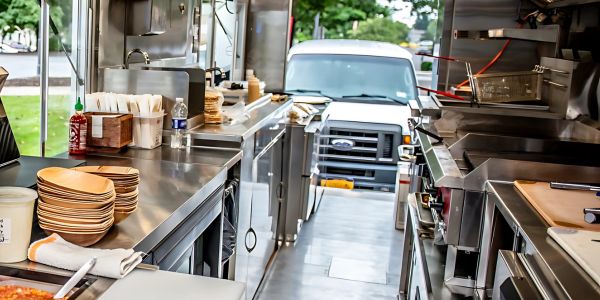Part III of the Food Truck Trenches Series: Nail Financing & Your Rig—Fast
Launching a food truck is exhilarating. You’ve nailed your menu, scouted your perfect pitch spots, and drafted a killer business plan. Now comes the fun (and slightly terrifying) part: securing the cash and landing the right truck.
Skip the overwhelm! In this Food Truck Trenches article, we bring hard-hitting financing tactics and the insights you need for: securing capital, prepping your loan pitch, and sourcing the world's best food truck!
Table of Contents
1. Financing Your Food Truck: Options That Don’t Give You a Heart Attack
2. Get Creative with Funding: Crowdfunding, Grants & More
3. Nail Your Loan Prep: Docs, Demos & Dollar Signs
4. Buy vs. Lease vs. Rent: Which Model Suits You?
5. What to Look For in Your Rolling Kitchen

Vendor Shopping: Score a Truck Without Getting Burned
Financing Your Food Truck: Options That Don’t Give You a Heart Attack
Securing funds is often the biggest hurdle. You’ve mapped your menu, tested recipes, and locked in your location—but without capital, none of those matter. Here’s how to raise money without losing sleep:
Equipment Loans & Vendor Leasing
Many entrepreneurs start by financing appliances, not the entire vehicle. Attach-only equipment loans let you borrow up to $150,000 at competitive rates for 60 months—perfect for high-quality fryers or espresso machines—without touching your truck’s title. Alternatively, sale-leaseback programs let you refinance an existing rig, unlocking equity for build-out costs.
Truck & Term Loans
For a turnkey solution, an application-only food truck loan can cover up to $250,000 in short time. You won’t need mountains of collateral—your truck serves as the primary security—and some lenders even offer deferred payments to align with your off-season. If you can navigate paperwork, an SBA-backed loan offers rock-bottom interest rates and 10-year terms, though approvals can stretch 60–90 days.

Get Creative with Funding
Not every operator wants bank debt and that’s okay. Alternative funding can infuse both capital and popular support. And let’s be honest, a thriving food truck business thrives on vibes and community.
Crowdfunding Campaigns
Platforms like Kickstarter let you pre-sell menu items or VIP experiences. Highlight your unique concept, share mouthwatering photos, and promise backers “Founding Foodie” swag.
Grants & Competitions
From city economic development funds to culinary incubators, competitive grants ranging $5K–$50K are out there—especially if you qualify as a minority- or veteran-owned business. Pro tip: check your local Small Business Development Center (SBDC) for listings.
Private Investors & Revenue-Share Deals
Pitch friends, family, or angel investors with a clear profit-share or equity arrangement. Transparency on returns is non-negotiable—nobody likes hidden clauses once the tacos start flying.
By diversifying your funding sources, you reduce reliance on any single lender and build early brand advocates.

Nail Your Loan Prep: Docs, Demos & Dollar Sign
Before you hit “Submit” on that loan application, get organized. Lenders want to see you’ve dotted your i’s and crossed your t’s.
Budget Like a Boss
Itemize truck cost, build-out, permits, insurance, plus 3 months’ working capital and a 10–20% contingency buffer.
Polish Your Business Plan
Executive summary, market analysis, menu differentiation, 3-year P&L projections, and break-even analysis.
Clean Up Credit
Pull personal & business credit reports, dispute errors, and pay down high-interest balances. Even a 20-point FICO bump saves thousands in interest.
Assemble the Docs
Two years’ tax returns, recent bank statements (3–6 months), equipment quotes, business licenses, and entity formation docs (LLC, EIN).
Shop & Compare
Rate-sheet showdown: banks vs. credit unions vs. online lenders vs. vendor programs. Ask about origination fees and prepayment penalties.
Pitch with Confidence
Treat your meeting like an investor pitch: be succinct, data-driven, and ready to defend every number—with enthusiasm.
A neat, complete application not only speeds approval but also positions you as a serious professional.

Buy vs. Lease vs. Rent: Which Model Suits You?
Deciding how to acquire your rig is as important as choosing your menu. Here’s a quick comparison, then we’ll delve into pros and cons.
-(1).jpg)
Buying a Food Truck
When you buy, you invest in full customization—from paint scheme to kitchen layout—and you can claim depreciation on your taxes. The downside? A $100K+ upfront hit, 3–6-month build-out timelines, and ownership headaches when things break.
Leasing / Rent-to-Own a Food Truck
A lease or rent-to-own arrangement lowers your initial cash burn and often includes buyout options. Lease payments might seem small, but over 5–7 years, you can end up paying 20–30% more than if you’d bought it outright.
Short-Term Rental of a Food Truck
Rentals shine for pop-ups or testing new markets. At $3K–$5K/month, you skip the long-haul commitment—but you also can’t customize, and availability can be spotty if you need the truck on short notice.

What to Look For in Your Rolling Kitchen
Finding the right truck can be tricky. Here’s what truly matters:
Truck vs. Trailer: Trucks offer curbside flexibility; trailers cost less to insure and work great for multi-day events.
Power & Utilities: Propane is a must for fryers; coffee bars often need 240V electric. Verify hood-vent specs, gas lines, and generator capacity before signing.
Workflow Layout: A linear “Tetris” layout—3-compartment sink + hand-wash station, refrigerated prep tables, cooking line, and service window—minimizes cross-traffic and boosts service speed.
Code Compliance: Every city has its own health, gas, electrical, and fire-suppression codes. Skipping this review can cost $10K+ in retrofits later.
New vs. Used: New trucks carry warranties and pristine builds; used rigs drop your capital investment but budget $5K–$10K for refurbishment and surprise fixes.
Vendor Shopping: Score a Truck Without Getting Burned
Once you know what you want, finding a trustworthy vendor is your next mission:
Custom Fabricators: Look for local shops with permit-expedite services and code expertise. They often bundle build-out and inspection assistance.
Online Marketplaces: Sites like Roaming Hunger, Used Vending, or even Facebook Marketplace can yield hidden gems. Always demand a detailed equipment list and condition photos.
Pre-Purchase Inspections: Spend $200–$500 on a dual inspection—mechanical (chassis, engine) and kitchen (plumbing, hood vents). That small outlay can save you $50K in unforeseen repairs.
Build a shortlist, interview each vendor, and ask for references from past clients. A vendor should be willing to share case studies and connect you with former customers. It is reasonable and good practice to ask for these. If they refuse or have none to give, you may want to take your roach-coach biz elsewhere.
Financing and finding your perfect food truck shouldn’t be a shot in the dark. By combining rigorous preparation—budgeting, credit cleanup, loan-prep—with creative funding hacks and a clear understanding of your acquisition options, you’ll minimize risk and launch faster.
Let’s Roll!